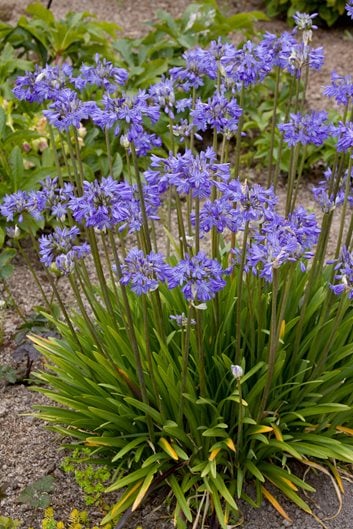Agapanthus Growing Problems: Dirt, Sunlight, and Watering
Agapanthus Growing Problems: Dirt, Sunlight, and Watering
Blog Article
Unleashing the Secret to Effective Agapanthus Growing: Advice for a Flourishing Yard
In the world of gardening, cultivating agapanthus efficiently calls for a calculated approach that includes different elements of plant treatment. By recognizing the nuances of agapanthus farming, one can create a setting where these plants thrive and flower generously.
Growing Agapanthus: Best Practices
When planting Agapanthus, proper dirt prep work is important for making sure effective development and development of these gorgeous blossoms. Agapanthus, commonly called Lily of the Nile or African lily, grows in well-draining soil with a somewhat acidic to neutral pH level - Agapanthus. Prior to planting, it is crucial to modify heavy clay soils with raw material such as garden compost or peat moss to boost water drainage and give vital nutrients for the plants
To grow Agapanthus, pick a location that obtains full sunlight to partial color, as this will certainly advertise healthy development and abundant flowering. Dig a hole twice the diameter of the plant's origin sphere and position the Agapanthus at the very same deepness it was formerly expanding. Delicately backfill the opening with dirt, pushing down firmly to get rid of any kind of air pockets around the origins.
Water the freshly grown Agapanthus completely and continue to keep the soil evenly moist, especially throughout the plant's energetic expanding season. Agapanthus. Applying a well balanced plant food once a month can further sustain the plant's growth and flowering. By following these best practices for growing Agapanthus, you can develop a magnificent screen of these fascinating flowers in your yard
Suitable Soil Issues for Agapanthus
For optimal growth and blooming success of Agapanthus plants, ensuring the dirt problems are suitable is vital. Agapanthus prospers in well-draining dirt with a slightly acidic to neutral pH degree ranging from 6.0 to 7.0. This kind of dirt permits ample water drain, preventing waterlogging which can lead to root rot. To enhance dirt drain, consider including raw material such as compost or peat moss when preparing the planting site. Additionally, Agapanthus chooses dirt that is rich in nutrients, so incorporating a well balanced fertilizer throughout the growing period can promote healthy and balanced growth and dynamic flowers.

Watering and Fertilizing Tips
To make certain healthy and balanced development and lively flowers, correct watering and fertilizing techniques are essential for effective Agapanthus growing. Agapanthus plants profit from routine watering, particularly during the expanding period.
When it involves fertilizing Agapanthus, a balanced plant food with equal components nitrogen, phosphorus, and potassium can be applied in the spring to advertise healthy and balanced growth and flowering. Slow-release plant foods are perfect for offering nutrients gradually over an extensive duration. Avoid over-fertilizing, as this can bring about extreme vegetation growth at the cost of blooms.
In addition, incorporating organic matter like garden compost right into the soil can boost nutrient levels and boost soil framework, helping in the total health and wellness of the Agapanthus plants. By following these watering and feeding suggestions, garden enthusiasts can ensure their Agapanthus plants thrive and create sensational displays of flowers.
Trimming and Deadheading Techniques
Correct pruning and deadheading techniques play a critical function in keeping the health and wellness and visual appeals of Agapanthus plants, enhancing the important techniques of watering and fertilizing for effective cultivation. Trimming Agapanthus entails eliminating invested blossom heads, yellowing or article dead fallen leaves, and total shaping of the plant to promote better growth. Deadheading, the procedure of getting rid of faded blossoms, not only improves the plant's look but likewise encourages additional flowering.
When deadheading Agapanthus, it is suggested to clip off the blossom stem at the base utilizing sharp, tidy shears. This process reroutes the plant's power from seed manufacturing back into origin and vegetation growth, advertising a healthier and much more durable plant. Regular deadheading can prolong the growing period of Agapanthus and avoid self-seeding, which can cause congestion.
In terms of pruning, Agapanthus visit site typically gain from a light trim after blossoming to clean up the plant and motivate fresh growth. Reducing the invested blossom stems and getting rid of any kind of dead or broken foliage assists preserve the plant's vigor and overall appearance. Nevertheless, it is vital to prevent cutting into the crown of the plant, as this can deteriorate its wellness.

Protecting Agapanthus From Vermins and Diseases
Implementing efficient pest and condition administration approaches is critical to safeguarding the wellness and vitality of Agapanthus plants in cultivation. One common bug that influences Agapanthus is the Agapanthus borer, a caterpillar that tunnels into the plant, causing damage to the blossoms and leaves.
In addition to pests, Agapanthus are prone to diseases such as root rot and fungal leaf spots. By remaining vigilant and attending to parasite and condition concerns without delay, garden enthusiasts can aid their Agapanthus prosper and grow.
:max_bytes(150000):strip_icc()/agapanthus-growing-guide-7368912_06ba-bf1fa268243b451387986fbd1e2433b3.jpg)
Verdict
To conclude, successful farming of agapanthus needs appropriate planting methods, excellent dirt conditions, appropriate watering and feeding, routine pruning and deadheading, and security from illness and bugs. By complying with these tricks and pointers, garden enthusiasts can make certain a flourishing yard loaded with attractive sites agapanthus flowers. Agapanthus. Bear in mind to maintain consistent care and interest to information to advertise the health and wellness and long life of these spectacular plants
When planting Agapanthus, appropriate dirt prep work is important for making sure effective development and development of these stunning flowers.Water the recently grown Agapanthus completely and continue to maintain the soil evenly wet, specifically throughout the plant's energetic expanding period.For optimum development and growing success of Agapanthus plants, making certain the soil conditions are suitable is crucial. When hair transplanting or planting Agapanthus, ensure the soil is well-prepared to offer the required foundation for the plants to establish themselves effectively. One typical parasite that influences Agapanthus is the Agapanthus borer, a caterpillar that passages into the plant, triggering damage to the leaves and flowers.
Report this page